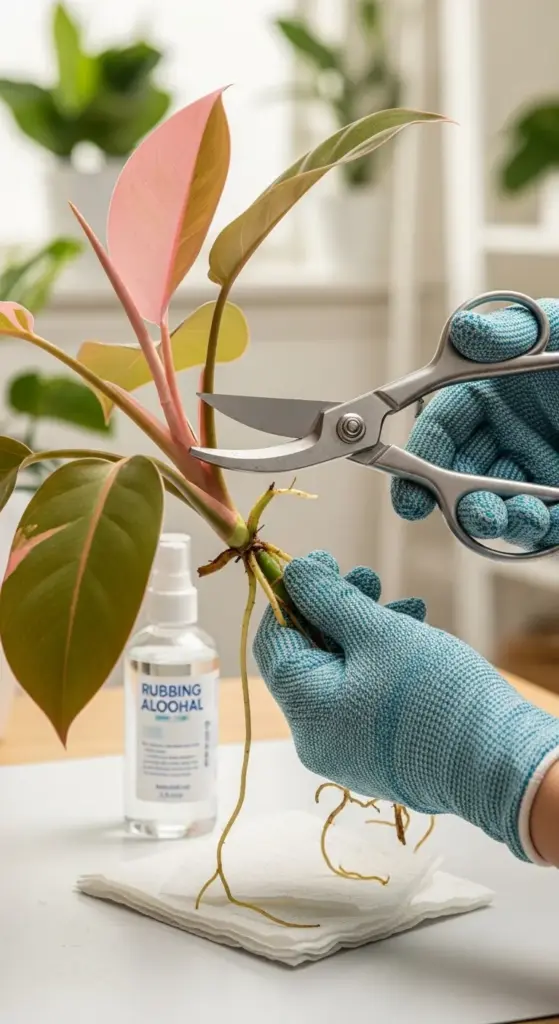4. The Pruning Strategy That Guarantees More Pink Leaves

I’m going to share the pruning technique that made my plant friends think I’d lost my mind. Cutting a $200 Pink Princess on purpose feels like financial suicide, but this method literally doubled my variegation output.
The first time I tried this, my hands were shaking so bad I could barely hold the scissors. Now it’s my secret weapon.
The Science Behind Strategic Cutting
Pruning forces your Pink Princess to activate dormant nodes, and here’s the kicker – stressed plants often produce more variegated growth as a survival mechanism.
When you cut the main growing tip, the plant panics (in a good way) and pushes energy into multiple new growth points. This is where the magic happens.
I discovered this accidentally when my cat knocked over my Pink Princess and snapped the main stem. Instead of dying, it exploded with three new growing points, all heavily variegated.
The key is cutting at the right spot – just above a node that already shows good variegation patterns. This tells the plant “hey, keep making more of this good stuff.”
How to Identify the Money Nodes
Look for nodes with pink or white aerial roots – these are your goldmine cutting spots. The coloration in the aerial roots often predicts the variegation in future leaves.
I use a magnifying glass to examine nodes closely. The best nodes have visible pink striping or mottled coloration in the stem tissue right at the node point.
Avoid cutting above nodes that are completely green or have only green aerial roots. These will likely produce mostly green growth, which defeats the whole purpose.
The sweet spot is usually 2-3 nodes down from the growing tip, where you can see established variegation patterns but still have active growth potential.
The Controversial Stress Pruning Method
This technique scared the hell out of me initially, but stress pruning involves cutting back up to 40% of your plant’s growth during peak growing season.
I know it sounds insane, but here’s what happens: the plant redirects all its energy into producing new, heavily variegated growth to compensate for the loss.
The timing is crucial – only do this in late spring or early summer when your plant is actively growing. Never stress prune during winter or when your plant is already struggling.
I cut my Pink Princess back from 3 feet tall to about 18 inches last May. By August, it had regrown to 4 feet with significantly more pink variegation than before.
My Exact Cutting Technique
Always cut at a 45-degree angle about 1/4 inch above the node you want to activate. This prevents water from sitting on the cut surface and causing rot.
I use sharp, clean pruning shears – never scissors or dull tools that crush the stem. A clean cut heals faster and reduces infection risk.
The cut should be smooth and decisive. Hesitant, sawing motions damage the stem tissue and create entry points for bacteria.
Make your cuts in the morning when the plant is fully hydrated. Afternoon cuts on stressed plants can cause excessive sap loss.
Propagation Secrets That Create Plant Babies
Here’s where pruning becomes profitable: every cutting with a node can become a new Pink Princess. I’ve turned one plant into seven using this method.
The key is taking cuttings that include at least one node and one aerial root. These root faster and maintain better variegation than node-only cuttings.
I root my cuttings in perlite mixed with a little sphagnum moss. Water propagation works but often produces weaker root systems that struggle when transplanted to soil.
For maximum success, I dip cutting ends in rooting hormone before placing them in the propagation medium. This isn’t absolutely necessary, but it speeds up the process significantly.
Tools and Sterilization That Prevent Disaster
Rubbing alcohol is your best friend when pruning expensive plants. I wipe my shears with 70% isopropyl alcohol between every single cut.
One contaminated cut can kill your entire plant through bacterial or fungal infection. I learned this lesson with a $300 Monstera that died from dirty pruning tools.
My essential tool kit: sharp bypass pruners, rubbing alcohol, clean paper towels, and rooting hormone. Never use anvil-type pruners – they crush stems instead of making clean cuts.
I also keep a small torch lighter handy to sterilize tools with flame if I’m doing major pruning work. The heat kills everything instantly.
The Timing That Makes or Breaks Success
Late spring through mid-summer is prime pruning season for Pink Princess. The plant has maximum energy reserves and growing momentum.
Never prune in fall or winter unless you’re removing dead or diseased tissue. The plant can’t recover quickly enough and may go into shock.
I do my major pruning in May, then smaller maintenance cuts throughout summer as needed. This gives the plant a full growing season to recover and flourish.
Watch for new growth patterns after pruning – you should see new shoots emerging within 2-3 weeks if you timed it right.
Reading Your Plant’s Response
Healthy post-pruning growth shows up as thick, sturdy stems with good variegation within a month of cutting. The plant should look bushier and more vigorous.
Warning signs include thin, weak growth or solid green leaves – this means your plant was too stressed or the timing was wrong.
If new growth is coming in mostly green, back off on fertilizer and increase light slightly. The plant is prioritizing survival over variegation, which means it needs better growing conditions.
Successful stress pruning results in multiple growing points with 40-60% variegation on new leaves.
The Results That Shocked Everyone
After implementing strategic pruning, my single Pink Princess became a full, bushy plant with 12 active growing points. Each point produces consistently variegated leaves.
I went from getting maybe one new leaf per month to 4-5 new leaves monthly across all the growing points. The transformation was honestly incredible.
The best part? I now have six additional Pink Princess plants from successful propagations, worth about $1,200 total. One brave pruning session literally paid for itself ten times over.
Common Pruning Mistakes That Kill Plants
Cutting too close to the node damages the growth point and prevents new shoots from emerging. Leave that 1/4 inch buffer zone religiously.
Using dirty tools is plant murder – I can’t stress this enough. Every cut is a potential infection site.
Another killer mistake: pruning weak or stressed plants. Only prune healthy, actively growing Pink Princess plants that can handle the shock and recover quickly.
And never, ever prune more than 50% of your plant at once. That’s not stress pruning, that’s plant torture.
Think pruning is intense? Wait until you discover the soil mix that most nurseries refuse to share with customers. Click “next” to learn the exact ingredient ratios that create perfect drainage while providing optimal nutrition – this recipe costs half as much as premium potting mixes and works twice as well!









GIPHY App Key not set. Please check settings